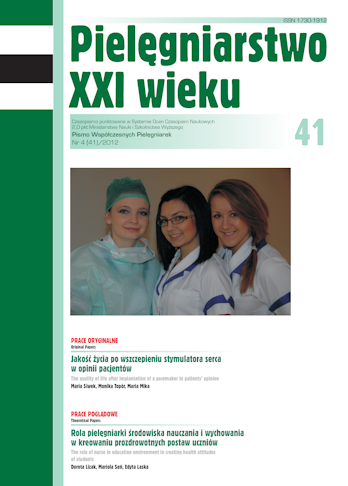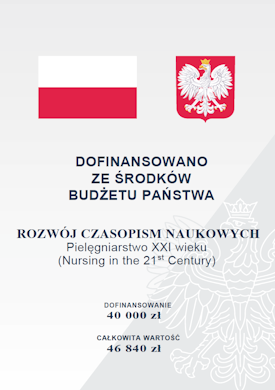Jakość życia po wszczepieniu stymulatora serca w opinii pacjentów
Słowa kluczowe:
jakość życia, stymulator sercaAbstrakt
JAKOŚĆ ŻYCIA PO WSZCZEPIENIU STYMULATORA SERCA W OPINII PACJENTÓW
Wstęp. Jakość życia jest pojęciem bardzo złożonym i obejmuje wszystkie płaszczyzny funkcjonowania człowieka. Na gruncie nauk medycznych jakość życia uwarunkowana jest stanem zdrowia rozumianej jako funkcjonalny efekt choroby i jej leczenia, przeżywany przez chorego. Dotyka obszaru stanu fizycznego i sprawności ruchowej, psychicznego, sytuacji społecznej i warunków ekonomicznych a także doznań somatycznych, obejmujących stan psychiczny pacjentów. Zaburzenia rytmu pracy serca prowadzące do objawowej bradykardii stanowią zagrożenie życia i wywierają wpływ na obniżenie jakości życia pacjenta. Implantowane stymulatory serca to nie tylko skomplikowane urządzenia stymulujące, ale także ratujące życie, dające poczucie bezpieczeństwa i komfort życia [1,2 ].
Cel pracy. Ocena jakości życia pacjentów po wszczepieniu rozrusznika serca.
Materiał i metodyka. Grupę badanych stanowili chorzy po wszczepieniu stymulatora serca (n = 124). W badaniu jakości życia po wszczepieniu kardiostymulatora wykorzystano standaryzowany kwestionariusz ankiety własnego autorstwa. Do analizy statystycznej wykorzystano: test U Manna Whitneya, test Kruskala-Wallisa, współczynnik τ Kendalla i gamma Kruskala, Pytania ankiety posłużyły do skonstruowania skal pomiarowych pozwalających analizować problemy codziennego życia chorych. Skale mają charakter porządkowy i pozwalają zastosować w praktyce takie metody statystyczne jak – rachunek korelacji, ANOVA Kruskala Wallisa, test Manna Whitneya. W przypadku konieczności zbadania związków pomiędzy zmiennymi typu jakościowego wykorzystane zostały tablice wielodzielcze i test chi kwadrat [3]. Poszczególnym odpowiedziom na pytania ankiety przyporządkowano punkty, które po zsumowaniu tworzą miarę natężenia zjawisk opisywanych danym obszarem.
Wyniki badań. W badanej grupie nastąpiła poprawa jakości życia w badanych obszarach, wykazano zależność między zmiennymi charakteryzującymi poszczególne obszary jakości życia a wiekiem, stanem cywilnym, wykształceniem, aktywnością zawodową. U 62,90% (n=78) badanych wystąpiła poprawa stanu zdrowia po wszczepieniu stymulatora, 45,97% (n=57) zwiększyło swoją aktywność i wysiłek fizyczny, a u 40,32% (n=50) wystąpiło złagodzenie objawów arytmii. Według 69,35% (n=86) badanych najbardziej negatywnym aspektem życia po wszczepieniu stymulatora serca było ograniczenie ruchu kończyną po stronie wszczepionego urządzenia, a 37,10% (n=46) obawiało się zaburzeń pracy stymulatora serca.
Wnioski. Ankietowani w pozytywny sposób określają swoją jakość życia, przystosowali się do funkcjonowania z wszczepionym stymulatorem serca, oraz czerpią satysfakcję z życia pomimo ograniczeń na jakie wpływa posiadany rozrusznik. Wykazano również istotną statystycznie zależność dla zmiennych charakteryzujących poszczególne obszary jakości życia a wiekiem, wykształceniem, sytuacją ekonomiczną, relacjami z osobami bliskimi oraz czasem jaki minął od momentu implantacji stymulatora serca. Wysoki poziom lęku spowodowany obawą o możliwość wystąpienia zaburzeń pracy stymulatora nasuwa celowość wdrożenia dodatkowych form opieki medycznej i edukacji.
Bibliografia
1. Sierakowska M, Krajewska-Kułak E. Jakość życia w chorobach przewlekłych – nowe spojrzenie na pacjenta i problemy zdrowotne w aspekcie subiektywnej oceny. Pielęgniarstwo XXI wieku. 2004; 2: 23-26.
2. Okła W, Steuden S. Jakość życia w chorobie. Lublin: Wyd. KUL; 2007.
3. Sichipper H. Quality of life: Principles of the clinical paradig. Journal of psychosocial oncology. 1990; 9: 171–185.
4. Tobiasz –Adamczyk B. Wybrane elementy socjologii zdrowia i choroby. Kraków: Wydawnictwo Uniwersytetu Jagiellońskiego; 2000.
5. Kuśnierz J. Postępowanie z pacjentem ze wszczepionym urządzeniem – zło konieczne, czy niezbędny element terapii, a może jedno i drugie? Standardy kontroli urządzeń wszczepialnych. W Dobrym Rytmie. 2009; 9:21-29.
6. Yusuf S, Cairns JA, Camm AJ i wsp. Kardiologia faktów Evidence - based. Centrum Warszawa: Wydawnictw Medycznych; 2005.
7. Wytyczne dotyczące stymulacji serca i resynchronizacji. Grupa Robocza Europejskiego Towarzystwa Kardiologicznego ds. stymulacji serca i resynchronizacji we współpracy z Europejskim Towarzystwem Rytmu Serca European Heart Journal. 2007; 28: 2256–2295.
8. Stanisz A. Przystępny kurs statystyki z zastosowaniem STATISTICA.PL na przykładach z medycyny. Kraków: StatSoft; 2004.
9. Młynarska A, Młynarski R, Korgul W. Zmiany jakości życia po 6 miesiącach od implantacji stymulatora serca. Polski Przegląd Kardiologiczny. 2010; 2:116-120.
10. Reczek A, Stańczykiewicz – Kudła K, Brzostek T i wsp. Jakość życia chorych po wszczepieniu stymulatora serca. Pielęgniarstwo Chirurgiczne i Angiologiczne. 2011; 2: 107 – 113.
11. Dugmore LD, Timpson RJ, Phillips MH i wsp. Changes in cardiorespiratory fitness, psychological wellbeing, quality of life, and vocational status following a 12 month cardiac exercise rehabilitation programme. Heart. 1999; 81: 359–366.
12. Vitatron BV. O stymulatorze serca. Stanowisko Vitatron. Arnhem: BV; 2004.
13. Dylewicz P, Jegier A, Piotrowicz R i wsp. Kompleksowa rehabilitacja kardiologiczna -Socjoekonomiczne aspekty rehabilitacji kardiologicznej. Folia Cardiol. 2004; 11: 42-45.
14. Camm AJ, Lüscher TF, Serruys P. [W:] Podręcznik Europejskiego Towarzystwa Kardiologicznego. Choroby serca i naczyń. tom II Poznań: Termedia; 2006/2007.
15. Gribbin GM, Kenny RA, McCue P et al. Individualised quality of life after pacing. Doesmode matter? Europace. 2004;6:552 -560.
16. Głebocka A, Szarzyńska M. Wsparcie społeczne a jakość życia ludzi starszych. Gerontologia Polska. 2005;4:255-259.
17. Dyga – Konarska M, Bieganowska K. Jakość życia dzieci i młodzieży ze stymulatorem serca w ocenie pacjentów. Folia Cardiologica. 2003;6:809-816.
Pobrania
Opublikowane
Numer
Dział
Licencja
Prawa autorskie (c) 2012 Maria Siwek, Monika Topór, Maria Mika (Autor)

Utwór dostępny jest na licencji Creative Commons Uznanie autorstwa 4.0 Międzynarodowe.




